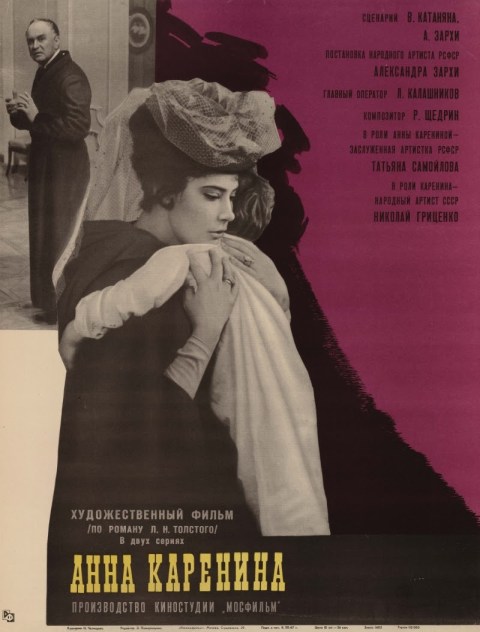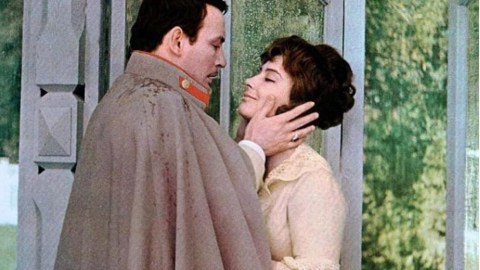17. 4. – 19. 4. 2026
Anna Karenina

 Original title: Анна Каренина
Original title: Анна КаренинаDirector: Alexandr Zarchy
Production: 1967, USSR
Length: 145 min.
Screened:
KRRR! 2014: 70mm 2.2:1, Colours partly faded, MG, Spoken language: Russian, Subtitles: CzechAnnotation for KRRR! 2014
Leo Tolstoy's novel Anna Karenina (1878) is part of the canon of world literature and a group of several classics that have been most frequently adapted for film over the past hundred years. Each subsequent adaptation represents a new approach motivated by a different artistic intention or production context. The British adaptation by Joe Wright showed an ambitious staging on stage the year before last, but the Russian adaptation by Alexander Zarchi from 1967 represents a traditional faithful approach and, of all the adaptations made to date, is the most respectful of Tolstoy's original text.
The Soviet classic Zarchi began his almost sixty-year career in the 1930s. His film work is characterized by an emphasis on character and work with actors. He chose a biographical approach in his subjects and tried to capture the most striking and essential moments from the story of the character being portrayed. The characters he chose are characterized by an unusual inner world. When writing the script, he had already considered specific actors in order to adapt to the possibilities and specificities of individual actors and actresses. He spoke of a method of acting specialisation through which one could penetrate the essence of the character. He compared his ideas with the behaviour of real characters and his ideal was to be able to portray a single person in many positions and with a developed emotional experience. His masterpiece Anna Karenina allowed him to fully utilise and fulfil all the principles outlined.
The most famous performers of the tragic female character include big stars: Greta Garbo (1935), Vivien Leigh (1948), and more recently Keira Knightley (2012). The Russian transcription offered an opportunity to Tatyana Samoilova, who had become famous ten years earlier in Mikhail Kalatozov's opus The Cranes Are Moving (1957). Anna Karenina is again a character with a moving fate for her, a woman torn by emotions and oppressed by social conventions. Therefore, it allowed Samoilova to show a wide acting range. The young actress does not look as mature as her predecessor, but she is beautiful and bewitching thanks to her deep black eyes, and her performance is fabulous. Interestingly, the supporting role of the beautiful and elegant Princess Betsy was played by prima ballerina Maya Plisetskaya. The Russian dancer, choreographer and actress is considered one of the most important ballerinas of the 20th century. In 1974, she initiated a new adaptation of the novel Anna Karenina and in this adaptation she herself played the main role.
The key component for capturing the film is the soundtrack and camera work. The city scenes take place almost exclusively in interiors, which enhance the rigidity and falseness of urban society, and contrast with the open plains of the free-breathing countryside, associated with the character of the honest Levin. The scenes from his environment are harmonious and are accompanied by the singing of birds in the soundtrack. The story of Anna Karenina is characterized by strong emotions and experiences. In the dramatic episodes of the love triangle, the music of Rodion Shchedrin stands out, which intensifies the viewer's experience and fixes our attention and tense expectations at a selected moment. These key scenes are also characterized by dynamic work with the camera. In the gradation phase, it takes us through a long drive to the scene of the crime, where it unexpectedly moves, and a rapid sequence of handheld shots in combination with expressive music perfectly capture the atmosphere of tense moments. The climax is the horse race, where the brisk editing culminates in an expressive montage and double exposure of the heads of Anna, Vronsky and the horse.
The film, which lasts almost two and a half hours, is ingeniously constructed through a balanced alternation of milder and more turbulent passages: emotionally intense sequences are preceded by periods of relative calm, the temporality of which, however, becomes increasingly apparent as the minutes pass. The film thus succeeds in evocatively building a sense of growing emotions, pain and paranoia, which ultimately lead to the tragedy of a woman tortured by the shackles of the society of her time.